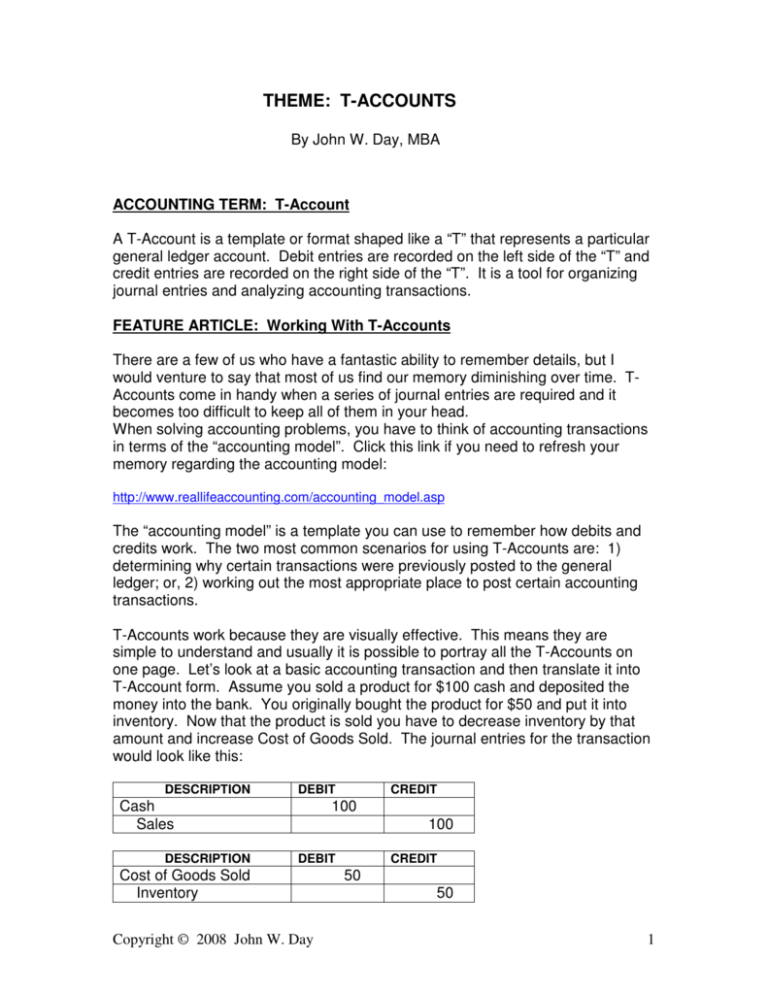theme: t-accounts - Real Life Accounting
advertisement

THEME: T-ACCOUNTS By John W. Day, MBA ACCOUNTING TERM: T-Account A T-Account is a template or format shaped like a “T” that represents a particular general ledger account. Debit entries are recorded on the left side of the “T” and credit entries are recorded on the right side of the “T”. It is a tool for organizing journal entries and analyzing accounting transactions. FEATURE ARTICLE: Working With T-Accounts There are a few of us who have a fantastic ability to remember details, but I would venture to say that most of us find our memory diminishing over time. TAccounts come in handy when a series of journal entries are required and it becomes too difficult to keep all of them in your head. When solving accounting problems, you have to think of accounting transactions in terms of the “accounting model”. Click this link if you need to refresh your memory regarding the accounting model: http://www.reallifeaccounting.com/accounting_model.asp The “accounting model” is a template you can use to remember how debits and credits work. The two most common scenarios for using T-Accounts are: 1) determining why certain transactions were previously posted to the general ledger; or, 2) working out the most appropriate place to post certain accounting transactions. T-Accounts work because they are visually effective. This means they are simple to understand and usually it is possible to portray all the T-Accounts on one page. Let’s look at a basic accounting transaction and then translate it into T-Account form. Assume you sold a product for $100 cash and deposited the money into the bank. You originally bought the product for $50 and put it into inventory. Now that the product is sold you have to decrease inventory by that amount and increase Cost of Goods Sold. The journal entries for the transaction would look like this: DESCRIPTION DEBIT Cash Sales DESCRIPTION CREDIT 100 100 DEBIT Cost of Goods Sold Inventory Copyright © 2008 John W. Day CREDIT 50 50 1 The T-Accounts would look like this: 100 50 Cash | Sales | 100 Cost of Goods Sold | Inventory | 50 You can easily see that the debits equal the credits. Let’s look at a more complex accounting transaction. (1) You bought a company van for $25,000 and you did this by putting $5,000 down and setting up a liability (Notes Payable) for $20,000. (2) You made your first payment of $380, of which $80 was interest, and (3) your first month’s depreciation was $833. To the unfamiliar, these transactions might appear confusing until T-Accounts are used. (1) Fixed Assets –Van 25,000 | (2) Notes Payable 300 | Cash | 5,000 Notes Payable | 20,000 Interest Expense 80 | (3) Depreciation Expense 833 | Cash | 380 Accumulated Depreciation | 833 A critical step is to make sure that the debits equal the credits. If not, you have made a mistake that must be solved. Next, simply put these T-Accounts in journal entry form: (1) DESCRIPTION DEBIT Fixed Assets - Van Cash Notes Payable (2) DESCRIPTION CREDIT 25,000 5,000 20,000 DEBIT Notes Payable Interest Expense Cash Copyright © 2008 John W. Day CREDIT 300 80 380 2 (3) DESCRIPTION DEBIT Depreciation Expense Accum Depreciation CREDIT 833 833 Remember that every account in the general ledger is a T-Account. Drawing the T-Account is just another way to portray the account. I can’t count the number of times that I have used the back of a napkin to draw T-Accounts to explain accounting concepts to clients. I can’t remember one time that a client was not able to follow me even though his/her accounting knowledge was minimal. The beauty of T-Accounts is their simplicity. QUESTION: Is There A Way To Keep Track Of Multiple T-Account Entries? The question is whether there is a way to keep track of multiple T-account entries. The answer is yes, and it is very important to do so to avoid confusion and mistakes. Usually you will be working with a series of transactions. Therefore, each transaction should be assigned a letter in alphabetical order. Use letters rather than numbers so there is no confusion between the order of the transaction and the numbers used in the transaction. Let’s assume the same transaction used above in the purchase of the van, but this time we will add some more transactions. For instance, before you bought the new van you sold an older van for $6,000. You used $5,000 of it for the down payment on the new van, and the remaining $1,000 to pay off the balance of a note on the old van. You originally bought the old van for $20,000 and had depreciated it down to $4,000. The first step in your organizational system is to identify all the transactions in sequential order and assign them a letter. For instance: (a) (b) (c) (d) (e) (f) (g) Sold the old van for $6,000 and deposited the money into the bank. Used the Miscellaneous Suspense account until the gain could be determined. Paid the old note off of $1,000. Removed the old van asset $20,000 from the books. Removed the accumulated depreciation of $16,000 on the old van from the books. Determined the gain from the sale of the old van of $2,000. Made a $5,000 down payment on a new van. Used the Miscellaneous Suspense account until all the purchase information was available. Recorded the purchase of the new van $25,000. Set up a liability on the new van of $20,000. Made first payment on the van note of $380 - $300 for principal and $80 for interest. Set up new depreciation schedule for the new van at $833 per month. Copyright © 2008 John W. Day 3 The next step is to arrange the T-Accounts in the order they are listed on your Chart of Accounts. Doing this makes it a little easier to locate the accounts, rather than having them scattered willy-nilly. Once this is done, start with transaction (a) and record the debits and credits to the T-Accounts. (Note that a previous balance in the account will be given the notation (BB) for beginning balance.) Cash (BB) 3,000 | 1,000 (b) (a) 6,000 5,000 (d) 380 (f) Fixed Assets - Vans (BB) 20,000 | 20,000 (c) (e) 25,000 Accumulated Depreciation (c) 16,000 | 16,000 (bb) 833 (g) Miscellaneous Suspense (c) 6,000 | 6,000 (a) (d) 5,000 5,000 (e) Notes Payable-Vans (b) 1,000 | 1,000 (BB) (f) 300 20,000 (e) Gain/Loss Disposition of Assets | 2,000 (c) Interest Expense (f) 80 | Depreciation Expense (g) 833 | You can see that, with all these numbers, it would be easy to forget where they came from. However, with each transaction identified by letter, the related entries can be quickly traced back to their original source. If you are so inclined, go though each transaction and locate the entries in the T-Accounts by letter. Make sure you understand the accounting logic for each entry. This exercise will give you a good handle as to how T-Accounts work. TIP: Summarizing Your Work If you are only trying to figure out how some journal entries should be written, then it is not necessary to summarize the T-Accounts for the ending account balance. However, there are times when you may want to know the ending balance of an account in order to compare it with the account balance found on a financial statement or general ledger. The method for doing this is as follows: Copyright © 2008 John W. Day 4 When you are done posting, add your debit and credit columns, draw a line and subtract one from another, with the difference remaining. Cash (BB) 3,000 | 1,000 (b) (a) 6,000 5,000 (d) 380 (f) ___________________ 9,000 | 6,380 ___________________ 2,620 ===== | Fixed Assets - Vans (BB) 20,000 | 20,000 (c) (e) 25,000 ______________________ 45,000 | 20,000 ______________________ 25,000 | ====== Accumulated Depreciation (c) 16,000 | 16,000 (BB) 833 (g) ____________________ 16,000 | 16,833 _____________________ | 833 ===== Notes Payable-Vans (b) 1,000 | 1,000 (BB) (f) 300 20,000 (e) ______________________ 1,300 | 21,000 ______________________ | 19,700 Miscellaneous Suspense (c) 6,000 | 6,000 (a) (d) 5,000 5,000 (e) ______________________ 11,000 | 11,000 ______________________ 0 ===== | 0 ===== Gain/Loss Disposition of Assets | 2,000 (c) ===== ====== (f) Interest Expense 80 | ==== Depreciation Expense (g) 833 | ==== Using T-Accounts to help solve accounting problems is one of your most valuable tools. The next time you are struggling with how to post a transaction try using T-Accounts. From that moment on, “you won’t leave home without them”. John W. Day, MBA is the author of two courses in accounting basics: Real Life Accounting for NonAccountants (20-hr online) and The HEART of Accounting (4-hr PDF). Visit his website at http://www.reallifeaccounting.com to download his FREE e-book pertaining to small business accounting and his monthly newsletter on accounting issues. Ask John questions directly on his Accounting for NonAccountants blog. Copyright © 2008 John W. Day 5







